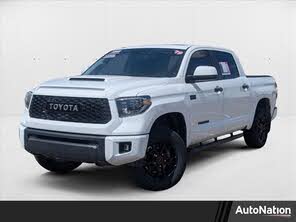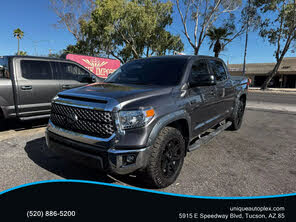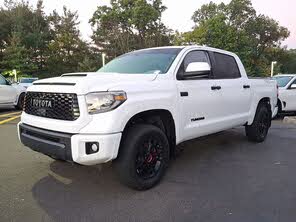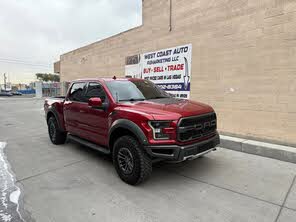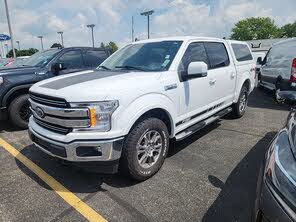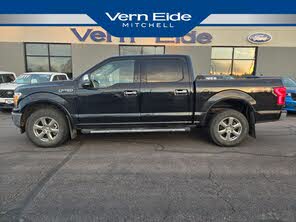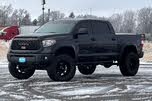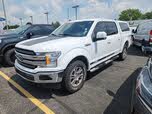2019 Toyota Tundra vs 2019 Ford F-150
Overview | |
MSRP$31,670 | MSRP$28,155 |
Listings595 | Listings5436 |
Ratings & Reviews | |
User Reviews | User Reviews |
Expert reviews6.3 out of 10 | Expert reviews8.2 out of 10 |
Pros
Cons
| |
2019 Toyota Tundra Reviews SummaryWhen it comes to pickups, simplicity used to be king. Leaf-spring suspensions, pushrod V8s, and no-nonsense interiors were staples of the game. But today, pickups include all sorts of sophisticated features, from car suspensions and twin-turbocharged engines to all the luxury and technology you’d expect from a luxury import. But the Toyota Tundra has refused to follow the herd, offering the tried-and-true formula that’s been a proven winner for decades. For some, that simplicity is a turnoff. But for others, it's exactly what’s missing from today’s truck offerings. For 2019, the TRD Pro trim returns, giving the Tundra a revised suspension, gorgeous new BBS wheels, and a price tag inflated by nearly $4,000. | |
2019 Ford F-150 Reviews SummaryThe notion of "luxury trucks" might seem a little weird if you haven’t bought a new truck in 20 years, but anyone who's been in the market lately should be more than familiar with the idea. Not only that, they should be more than accustomed to the sticker shock associated with these high-end, luxury pickups. Some old-school types will scoff at how trucks have gotten soft or too expensive (or both), but good automakers build the cars and trucks people want, and shoppers have been snatching luxury trucks as fast as they can be built and shipped. These "soft" trucks offer a template for seemingly dozens of purposes. They can tow, haul, carry people and goods, play road-trip family car, and even be the ride for a night on the town. The Chevy Silverado, GMC Sierra, and Ram 1500 all got redesigned for 2019, while the F-150 was last updated in 2018, following a full redesign for 2015. There are a few modest feature updates for 2019 as well, but will that be enough when the F-150’s main competition is all-new for the same model year? | |
Popular Features & Specs | |
Engine4.6L 310 hp V8 | Engine3.3L 290 hp V6 Flex Fuel Vehicle |
Drive Train4X2 | Drive Train4X2 |
Seating Capacity6 | Seating Capacity3 |
Horsepower310 hp @ 5600 rpm | Horsepower |
MPG City15 | MPG City19 |
MPG Highway19 | MPG Highway25 |
Engine | |
Engine Name4.6L 310 hp V8 | Engine Name3.3L 290 hp V6 Flex Fuel Vehicle |
Torque327 lb-ft @ 3400 rpm | Torque |
Horsepower310 hp @ 5600 rpm | Horsepower |
Drivetrain4X2 | Drivetrain4X2 |
Fuel Economy | |
MPG City15 | MPG City19 |
MPG Highway19 | MPG Highway25 |
Interior | |
Seating Capacity6 | Seating Capacity3 |
Safety | |
Front Crash Overall4 | Front Crash Overall4 |
Side Crash Overall5 | Side Crash Overall5 |
Dimensions & Capacity | |
Bed Length78.7 in | Bed Length78.9 in |
Cargo Space | Cargo Space12.1 cu ft |
Curb Weight5100 lbs | Curb Weight4069 lbs |
Height76.0 in | Height75.5 in |
Length228.9 in | Length209.3 in |
Width79.9 in | Width96.8 in |
Wheelbase145.7 in | Wheelbase122.4 in |
Maximum Payload1600 lbs | Maximum Payload1990 lbs |
Number of doors4 | Number of doors2 |
Maximum Towing Capacity6800 lbs | Maximum Towing Capacity9200 lbs |
Standard Towing Capacity6800 lbs | Standard Towing Capacity5100 lbs |
Overview | ||
MSRP | $31,670 | $28,155 |
Listings | ||
Ratings & Reviews | ||
User reviews | ||
Expert reviews | 6.3 out of 10Read full review | 8.2 out of 10Read full review |
Pros & cons | Pros
Cons
| |
Summary | When it comes to pickups, simplicity used to be king. Leaf-spring suspensions, pushrod V8s, and no-nonsense interiors were staples of the game. But today, pickups include all sorts of sophisticated features, from car suspensions and twin-turbocharged engines to all the luxury and technology you’d expect from a luxury import. But the Toyota Tundra has refused to follow the herd, offering the tried-and-true formula that’s been a proven winner for decades. For some, that simplicity is a turnoff. But for others, it's exactly what’s missing from today’s truck offerings. For 2019, the TRD Pro trim returns, giving the Tundra a revised suspension, gorgeous new BBS wheels, and a price tag inflated by nearly $4,000. | The notion of "luxury trucks" might seem a little weird if you haven’t bought a new truck in 20 years, but anyone who's been in the market lately should be more than familiar with the idea. Not only that, they should be more than accustomed to the sticker shock associated with these high-end, luxury pickups. Some old-school types will scoff at how trucks have gotten soft or too expensive (or both), but good automakers build the cars and trucks people want, and shoppers have been snatching luxury trucks as fast as they can be built and shipped. These "soft" trucks offer a template for seemingly dozens of purposes. They can tow, haul, carry people and goods, play road-trip family car, and even be the ride for a night on the town. The Chevy Silverado, GMC Sierra, and Ram 1500 all got redesigned for 2019, while the F-150 was last updated in 2018, following a full redesign for 2015. There are a few modest feature updates for 2019 as well, but will that be enough when the F-150’s main competition is all-new for the same model year? |
Video | ||
Popular Features & Specs | ||
Engine | 4.6L 310 hp V8 | 3.3L 290 hp V6 Flex Fuel Vehicle |
Drive Train | 4X2 | 4X2 |
Seating Capacity | 6 | 3 |
Horsepower | 310 hp @ 5600 rpm | |
MPG City | 15 | 19 |
MPG Highway | 19 | 25 |
Engine | ||
Engine Name | 4.6L 310 hp V8 | 3.3L 290 hp V6 Flex Fuel Vehicle |
Torque | 327 lb-ft @ 3400 rpm | |
Horsepower | 310 hp @ 5600 rpm | |
Drivetrain | 4X2 | 4X2 |
Fuel Economy | ||
MPG City | 15 | 19 |
MPG Highway | 19 | 25 |
Interior | ||
Seating Capacity | 6 | 3 |
Safety | ||
Front Crash Overall | 4 | 4 |
Side Crash Overall | 5 | 5 |
Dimensions & Capacity | ||
Bed Length | 78.7 in | 78.9 in |
Cargo Space | 12.1 cu ft | |
Curb Weight | 5100 lbs | 4069 lbs |
Height | 76.0 in | 75.5 in |
Length | 228.9 in | 209.3 in |
Width | 79.9 in | 96.8 in |
Wheelbase | 145.7 in | 122.4 in |
Maximum Payload | 1600 lbs | 1990 lbs |
Number of doors | 4 | 2 |
Maximum Towing Capacity | 6800 lbs | 9200 lbs |
Standard Towing Capacity | 6800 lbs | 5100 lbs |
The 2019 Toyota Tundra had its roots reviewed back in 2016, with many critics noting that it felt outdated compared to competitors from Ford, Chevy, and Dodge. Fast forward three years, and not much had changed. Toyota had made some subtle updates to try and keep the Tundra in the race, but technology still felt like an afterthought. The interior’s appearance remained largely the same, and the V8 engines paired with the 6-speed automatic transmissions stood out as relics of a bygone era—thirsty for fuel and lacking the advancements seen in other brands. Yet, there was a segment of pickup-truck shoppers who sought these very attributes. Rugged dependability was a hallmark associated with Toyota, and many consumers valued that highly.
Toyota provided the Tundra in six trims, all powered by one of two V8 engines paired with a 6-speed automatic transmission. The base SR trim came with features including heated mirrors, a windshield wiper de-icer, a damped tailgate, integrated trailer-brake controller, and a comprehensive safety suite with forward-collision warning and automatic emergency braking, adaptive cruise control, lane-departure warning, and auto high beams. The 6.1-inch touchscreen provided Bluetooth connectivity, and the 6-speaker stereo included a CD player—all for $31,670. The base engine was a 4.6-liter V8 delivering 310 hp and 327 lb-ft of torque.
The SR5, priced at $33,470, included an upgraded 7-inch touchscreen interface with navigation, HD and satellite radio, foglights, and improved windshield wipers. Stepping up to the Limited trim raised the price to $40,935, adding leather front bucket seats, power-adjustable features, dual-zone climate control, extended cab options, extra speakers, and a significant 38-gallon fuel tank when equipped with the 5.7-liter V8.
The Platinum and 1794 Edition trims, both at $47,630, introduced luxury with unique styling, sunroofs, heated and cooled front seats, and upgraded sound systems. The TRD Pro, where the Tundra truly shined, started at $49,895. It featured a 2-inch raised suspension, off-road tires with forged BBS wheels, Fox shocks, and numerous TRD-specific touches, resulting in a total price of $51,140 after fees.
Meanwhile, the 2019 Ford F-150, redesigned in 2015, had grabbed attention for its twin-turbocharged EcoBoost and the extensive use of aluminum in its body panels. Ford refreshed the truck in 2018, carrying over most of the design into 2019. Despite attempts from General Motors to tarnish the F-150's use of aluminum, hinting at its vulnerability in ads, the F-150 stood strong.
The F-150’s trims ranged from XL, XLT, Lariat, King Ranch, Platinum, Raptor, to Limited. The XL was a true work truck, sparse in features but functional with a reversing camera and a basic 4.2-inch audio screen. The XLT added conveniences like power windows, an 8-inch infotainment screen, and a USB port. The Lariat boasted leather interiors, heated and ventilated front seats, and satellite radio.
Our King Ranch model, introduced in 2001, had a luxurious interior with unique Camel Back upholstery and the iconic “flying W” embroidery. The Platinum model took it further with wood panel interiors and power-deploying running boards. The Raptor was built for off-road with a wide-body kit and Fox Racing Shox. The Limited trim presented ultimate luxury with 22-inch polished wheels, a dual-panel moonroof, dual exhaust, and massaging seats—features also found in our King Ranch model.


















The 2019 Toyota Tundra skipped turbocharged options, sticking to its V8s. The 4.6-liter V8 offered 310 hp and 327 lb-ft of torque, with a payload of 1,600 pounds and a towing capacity of 6,800 pounds. However, its size made it wise to opt for the larger engine. The 5.7-liter V8 provided 381 hp and 401 lb-ft of torque, increasing payload to 2,640 pounds and towing capacity to 10,000 pounds, with just a slight dip in fuel economy. The 4.6-liter with RWD managed an EPA-estimated 15 mpg city, 19 highway, while the 5.7 delivered 13/18.
The TRD Pro was the star of the lineup, competing aggressively with the Ford F-150 Raptor in off-road capability. It didn’t have the Raptor’s advanced tech but made up for it with an engaging driving experience.
The 2019 Ford F-150 introduced a new 3.0-liter Power Stroke turbodiesel V6 to its lineup, producing 250 hp and a massive 440 lb-ft of torque. The base engine remained a 3.3-liter V6 with 290 hp and 265 lb-ft. The 2.7-liter EcoBoost V6 offered 325 hp and 400 lb-ft, while the 3.5-liter EcoBoost V6 gave 375 hp, now including a 450-hp version formerly exclusive to the Raptor found in the Limited trim. The 5.0-liter Coyote V8 provided 395 hp and 400 lb-ft of torque.
The Power Stroke diesel could tow up to 11,400 pounds when properly equipped. The 10-speed automatic paired with all but the base trim allowed engines to operate efficiently, providing smooth acceleration and maintaining a quiet cabin, even with the diesel. Fuel economy stood at 22 mpg city, 30 highway for RWD, making it highly efficient.
The 2019 Toyota Tundra’s simplicity extended to its configurations. The 5.7-liter engine offered maximum towing capacity without the need for specific setups. However, its size posed a challenge, making entry and exit difficult without steps or running boards. Navigating city streets or tight trails required careful maneuvering to avoid scraping, a testament to its imposing dimensions.
The 2019 Ford F-150 offered a variety of configurations with single cab, extended SuperCab, and full 4-door SuperCrew. The SuperCrew model exhibited a spacious cabin, with deep cupholders, a large center console, and ample in-door storage. The rear bench could fold up for additional cargo space, ideal for stacking gear.
When comparing payload and towing capacities, the Tundra’s top configurations achieved up to 2,640 pounds payload and 10,000 pounds towing. The F-150 surpassed this with its top engines, offering up to 3,270 pounds payload and 13,200 pounds towing, demonstrating superior utility.
Technology lagged in the Tundra. Absent were Android Auto and Apple CarPlay, even in the $50,000 TRD Pro. Only one USB port was available, and it didn’t light up, complicating nocturnal navigation. Though Entune was user-friendly, its aging interface reflected the Tundra’s overall technological lag. In contrast, the F-150’s base XL model came with the basic Sync infotainment system. Higher trims featured Sync 3 with an 8-inch touchscreen, supporting Android Auto and Apple CarPlay. The King Ranch model included a Wi-Fi hotspot and a premium B&O Play sound system, enhancing connectivity and entertainment.
The 2019 Toyota Tundra received praise for its standard safety features, including adaptive cruise control, automatic emergency braking, lane-departure warning, auto high-beams, and a drowsiness monitor. However, blind-spot monitoring with cross-traffic alert was only available on higher trims. Despite these features, the Tundra’s age showed in safety ratings. NHTSA gave it four stars in frontal crash tests and five in side crash tests, but only three stars in rollover. IIHS tests reflected similar concerns with Marginal and Poor ratings in some areas and Acceptable roof strength.
The 2019 Ford F-150 came equipped with a complete set of front- and side-impact airbags, traction control, and a reversing camera. The top Limited trim and other models optionally offered a 360-degree camera system, enabling superior maneuverability. Additional driver-assistance features included blind-spot monitoring, forward-collision avoidance, adaptive cruise control, and rear cross-traffic alert.
CarGurus highlights

According to CarGurus experts, the overall rating for the 2019 Toyota Tundra is 6.3 out of 10, while the 2019 Ford F-150 scores 8.2 out of 10. Given these ratings, the Ford F-150 is the clear winner. With its advanced technology, superior towing and payload capacities, and a broader range of engine options, the F-150 offers more versatility and modern features. The Tundra’s rugged reliability and simplicity may appeal to a niche audience, but the F-150 stands out as the better choice for most consumers seeking a full-size pickup truck in 2019.
Choose the 2019 Toyota Tundra if:
- Rugged dependability and simplicity are top priorities.
- You prefer a straightforward V8 engine lineup without turbocharged options.
- Maximum off-road capability at a reasonable price appeals to you, specifically in the TRD Pro model.
Choose the 2019 Ford F-150 if:
- You value advanced technological features and connectivity with Sync 3, Android Auto, and Apple CarPlay.
- Superior towing and payload capacities are essential for your needs.
- Luxurious trims and features, including massaging seats and power-deploying running boards, are important to you.
CarGurus highlights

According to CarGurus experts, the overall rating for the 2019 Toyota Tundra is 6.3 out of 10, while the 2019 Ford F-150 scores 8.2 out of 10. Given these ratings, the Ford F-150 is the clear winner. With its advanced technology, superior towing and payload capacities, and a broader range of engine options, the F-150 offers more versatility and modern features. The Tundra’s rugged reliability and simplicity may appeal to a niche audience, but the F-150 stands out as the better choice for most consumers seeking a full-size pickup truck in 2019.
Choose the 2019 Toyota Tundra if:
Shop Now- Rugged dependability and simplicity are top priorities.
- You prefer a straightforward V8 engine lineup without turbocharged options.
- Maximum off-road capability at a reasonable price appeals to you, specifically in the TRD Pro model.
Choose the 2019 Ford F-150 if:
Shop Now- You value advanced technological features and connectivity with Sync 3, Android Auto, and Apple CarPlay.
- Superior towing and payload capacities are essential for your needs.
- Luxurious trims and features, including massaging seats and power-deploying running boards, are important to you.

By: CarGurus + AI
At CarGurus, our team of experienced automotive writers remain at the heart of our content operation, conducting hands-on car tests and writing insightful guides that are backed by years of industry experience. To complement this, we are harnessing AI to make our content offering more diverse and more helpful to shoppers than ever. To achieve this, our AI systems are based exclusively on CarGurus content, ratings and data, so that what we produce is both unique to CarGurus, and uniquely helpful to car shoppers.


